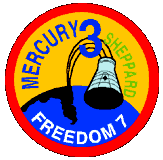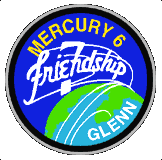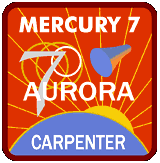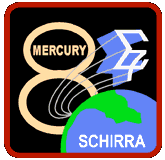| Astronauts | Atlas | Redstone | Missions | Patches | History |
Mercury Mission Data


| MR-3 (Freedom 7) | ||
| Launch: | May 5, 1961 |  |
| Vehicle: | Redstone | |
| Crew: | Alan B. Shepard, Jr | |
| Landing: | May 5, 1961 - Atlantic Ocean | |
| Duration: | 15 min, 28 seconds | |
| Objectives: | The main scientific objective of project Mercury was to determine man's capabilities in a space environment and in those environments to which he will be subject upon going into and returning from space. A few of the basic flight problems included: The development of an automatic escape system, vehicle control during insertion, behavior of space systems. evaluation of pilots capabilities in space, in flight monitoring, retrofire and reentry maneuvers and landing and recovery. | |
| Highlights: | First U.S. manned mission into space, first American in space, flight successful. | |

| MR-4 (Liberty Bell 7) | ||
| Launch: | July 21, 1961 |  |
| Vehicle: | Redstone | |
| Crew: | Virgil I "Gus" Grissom | |
| Landing: | July 21, 1961 - Atlantic Ocean | |
| Duration: | 15 min, 37 seconds | |
| Objective: | Confirm man-in-space concept. The main configuration differences between the MR-3 and MR-4 spacecraft was the addition of a large viewing porthole and an explosively activated side hatch. | |
| Highlights: | Flight Successful but spacecraft sank shortly after splashdown. | |

| MA-6 (Friendship 7) | ||
| Launch: | February 20, 1962 |  |
| Vehicle: | Atlas | |
| Crew: | John H. Glenn, Jr. | |
| Landing: | February 20, 1962 - Atlantic Ocean | |
| Duration: | 4 hours, 55 min, 23 seconds | |
| Objective: | Place a man into earth orbit, observe his reactions to the space environment and safely return him to earth to a point where he could be readily found. | |
| Highlights: | First American to orbit the Earth, flight successful. During flight two major problems were encountered: (1) a yaw attitude control jet apparently clogged, forcing the astronaut to abandon the automatic control system for the manual-electrical fly-by-wire system; and (2) a faulty switch in the heat shield circuit indicated that the clamp holding the shield had been prematurely released- a signal later found to be false. During reentry, however, the retropack was not jettisoned but retained as a safety measure to hold the heat shield in place in the event it had loosened. | |

| MA-7 (Aurora 7) | ||
| Launch: | May 24, 1962 |  |
| Vehicle: | Atlas | |
| Crew: | Scott Carpenter | |
| Landing: | May 24, 1962 | |
| Duration: | 4 hours, 56 min, 5 seconds | |
| Objective: | Confirm man-in orbit | |
| Highlights: | The focus of Carpenter's five-hour Aurora 7 mission was on science. The full flight plan included the first study of liquids in weightlessness, Earth photography and an unsuccessful attempt to observe a flare fired from the ground. At dawn of the third and final orbit, Carpenter inadvertently bumped his hand against the inside wall of the cabin and solved a mystery from the previous flight. The resulting bright shower of particles outside the capsule-what Glenn had called "fireflies"-turned out to be ice particles shaken loose from the capsule's exterior. Like Glenn, Carpenter circled the Earth three times.
Total time weightless 4 h 39 min 32 s. The performance of the Mercury spacecraft and Atlas launch vehicle was excellent in nearly every respect. All primary mission objectives were achieved. The single mission critical malfunction which occurred involved a failure in the spacecraft pitch horizon scanner, a component of the automatic control system. This anomaly was adequately compensated for by the pilot in subsequent in-flight operations so that the success of the mission was not compromised. A modification of the spacecraft control-system thrust units were effective. Cabin and pressure-suit temperatures were high but not intolerable. Some uncertainties in the data telemetered from the bioinstrumentation prevailed at times during the flight; however, associated information was available which indicated continued well-being of the astronaut. Equipment was included in the spacecraft which provided valuable scientific information; notably that regarding liquid behavior in a weightless state, identification of the airglow layer observed by Astronaut Glenn, and photography of terrestrial features and meteorological phenomena. An experiment which was to provide atmospheric drag and color visibility data in space through deployment of an inflatable sphere was partially successful. The flight further qualified the Mercury spacecraft systems for manned orbital operations and provided evidence for progressing into missions of extended duration and consequently more demanding systems requirements. Partly because he had been distracted watching the fireflies and partly because of his busy schedule, and a malfunction of the automatic alignment system, he overshot his planned reentry mark, and splashed down 402 kilometers off target. | |

| MA-8 (Sigma 7) | ||
| Launch: | October 3, 1962 |  |
| Vehicle: | Atlas | |
| Crew: | Walter M. Schirra, Jr. | |
| Landing: | October 3, 1962 | |
| Duration: | 9 hours, 13 min, 11 seconds | |
| Objective: | Man-machine in orbit for 9 hours. | |
| Highlights: | Mercury 8 was a Mercury program manned space mission launched on
October 3, 1962. The capsule was named "Sigma 7" and completed six earth orbits piloted by astronaut Wally Schirra. It was the first flawless Mercury mission.
Schirra's was the first of two longer-duration Mercury missions. After Carpenter's flawed reentry, the emphasis returned to engineering rather than science (Schirra even named his spacecraft "Sigma" for the engineering symbol meaning "summation.") The six-orbit mission lasted nine hours and l3 minutes in a free drift that tested the Mercury's autopilot system. Schirra also tried steering by the stars, took photographs with a Hasselblad camera, exercised with a bungee-cord device, saw lightning in the atmosphere, broadcast the first live message from an American spacecraft to radio and TV listeners below, and made the first splashdown in the Pacific. This was the highest flight of the Mercury program, with an apogee of 283.24 kilometers. Sigma 7 landed near the international date line in the Pacific Ocean, 275 miles (440 km) NE of Midway Island. | |

| MA-9 (Faith 7) | ||
| Launch: | May 15, 1963 |  |
| Vehicle: | Atlas | |
| Crew: | L. Gordon Cooper | |
| Landing: | May 16, 1963 | |
| Duration: | 1 Day, 10 hours, 19 min, 49 seconds | |
| Objective: | Manned 1-day mission in orbit | |
| Highlights: | Mercury 9 was the last U.S. Mercury spaceflight manned space mission, launched on
May 15, 1963 from Launch Complex 14 at Cape Canaveral, Florida. The capsule was named Faith 7 and it completed 22 Earth orbits piloted by astronaut Gordon Cooper.
The flight of Sigma 7 had been so nearly perfect that some at NASA thought America should quit while it was ahead and make MA-8 the last Mercury mission, and not risk the
chance of future disaster. They thought NASA had pushed the first-generation Mercury hardware far enough, and taking more chances on another longer mission were not warranted.
They thought it was time to move on to the Gemini program.
Manned Spacecraft Center officials, however, believed that the Mercury team should be given the chance to test man in space for a full day. On the nineteenth orbit, the first sign of trouble appeared when the spacecraft 0.05 g (0.5 m/s²) light came on. The spacecraft was not reentering, it was a faulty indicator. On the 20th orbit, Cooper lost all attitude readings. The 21st orbit saw a short-circuit occur in the bus bar serving the 250 volt main inverter. This left the automatic stabilization and control system without electric power. On the 21st orbit John Glenn, who was onboard the Coastal Sentry near Kyushu, Japan, helped Cooper prepare a revised checklist for retrofire. Due to the system malfunctions, many of the steps would have to be done manually. Cooper noted that the carbon dioxide level was rising in the cabin and in his spacesuit. Glenn told Carpenter as he passed over Zanzibar, "Things are beginning to stack up a little." Throughout the problems, Cooper remained cool, calm and collected. Fifteen minutes later the Faith 7 landed just four miles (6 km) from the prime recovery ship, the carrier USS Kearsarge. | |

